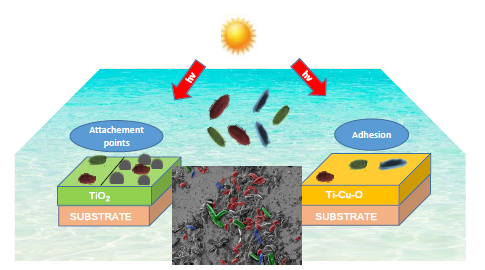
-
- au
Ici vous trouverez le papier de Caroline Villardi
"The actual interest in developing light-induced catalytic coatings to act as an antibiofouling alternative has recently prompted interest in the incorporation of Cu into TiO2 films, working as a visible light sensitizer catalyst. TiO2 and new Ti-Cu-O films with Cu contents ranging between 16% and 75% Cu/(Cu + Ti) are deposited by aerosol-assisted metalorganic chemical vapor deposition at a substrate temperature of 550 °C. The films are composed of TiO2 anatase phase, mixed with Cu2O when including Cu in the composition. Pure TiO2 films’ morphologies are characterized by the formation of microflower-like structures with nanometric petals, which induce a high specific surface. These features are not present in Ti-Cu-O films. A UV-Visible study revealed that the optical band gap energy decreases with increasing Cu content. Interestingly, Ti-Cu-O films presented a highly photo-catalytic activity in the orange-G degradation. Marine biofouling field tests in Lorient’s Harbor in France and in vitro tests were carried out in order to evaluate the antifouling performance of the films, revealing that topography and chemical composition can act differently on different species. Field tests revealed that TiO2 microflowers reduced the fouling coverage. Besides, Ti-Cu-O films with 16 at.% Cu presented lower fouling coverage than films containing 58 at.% Cu. In vitro tests using two diatoms (P. tricornutum and N. perminuta) showed that the spaces between microflowers play a significant role in the adhesion of diatoms: microalgae adhere less when spaces are bigger than their cells, compared to when spaces are of the same size as cells. Films containing Cu did not alter N. perminuta growth nor adhesion, while they affected P. tricornutum by lowering its growth rate and adhesion without noticeable toxicity. Indeed, Cu-Ti-O is a very promising non-toxic fouling release film for marine and industrial applications."


